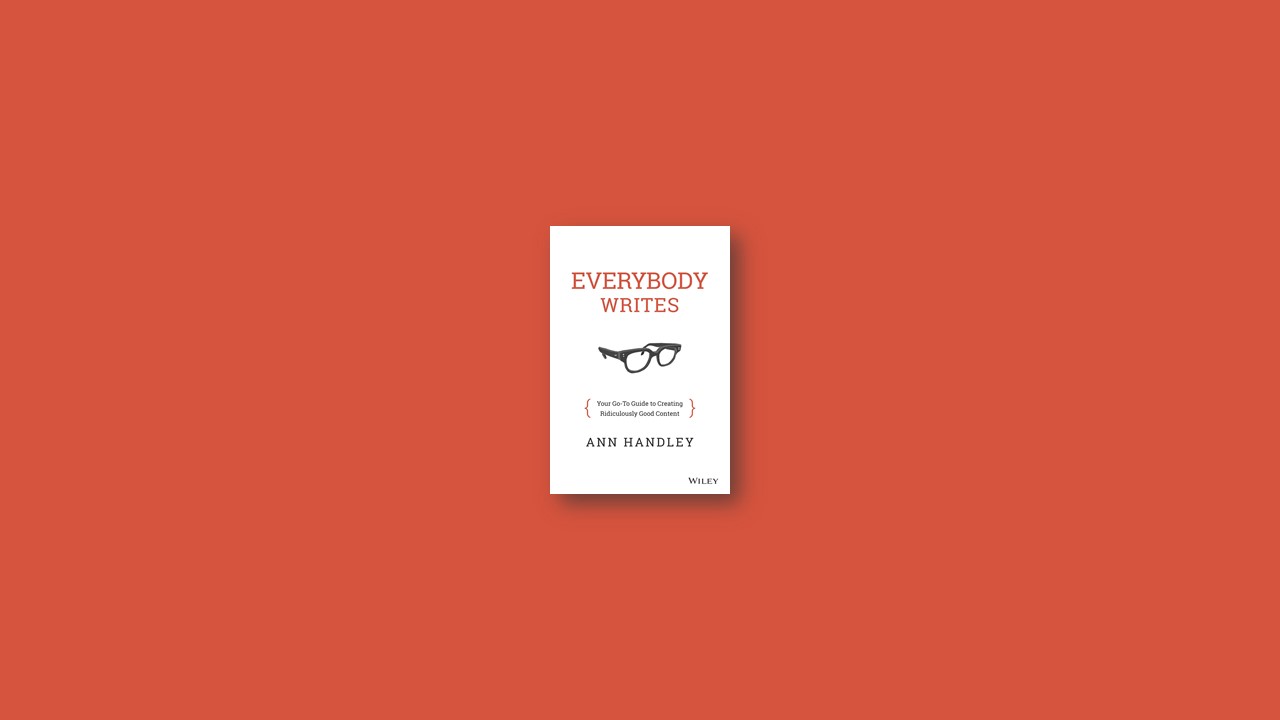Everybody Writes
“If you want to be a writer you must do two things above all others: read a lot and write a lot,” Stephen King writes in his book On Writing. He is talking to those who want to make their living as he does, writing books. But, in our world, we’re all already writing and reading a lot. Every day.
I am a writer. You are a writer. Everybody writes.
Writing Is a Habit, Not an Art
We’re tempted to think that writing is an art, that only an anointed lucky few can do it well. But that’s an excuse—a justification that lets the lazy among us off the hook for being the communication equivalent of a couch potato: flabby, unmotivated, inarticulate. But the truth is that the key to being a better writer is, essentially, to be a more productive one. Or more simply, the key to being a better writer is to write
Simply put, the key to being a better writer is to write.
- Set aside time each day when you’re freshest.
- Don’t write a lot. Just write often.
- There are no shortcuts to becoming a better writer. So show up at your desk and get to it. Daily.
Shed High School Rules
Many of us learned in high school to write what is commonly known as the five-paragraph essay, similar in format to the soon-to-be-former SAT test. It goes something like this:
Introduction. The introduction is a thesis statement or a kind of mini-outline of what the essay will cover.
Body Paragraph One. Body paragraph one should include the strongest argument, most compelling example, or cleverest point that dramatizes your thesis.
Body Paragraph Two. Body paragraph two should include the second-strongest argument, compelling example, or cleverest point.
Body Paragraph Three. Body paragraph three should include the third (or weakest) argument, example, or point.
Conclusion. Your conclusion should be a restatement of the thesis statement that uses some of the original words to echo—but not duplicate—the opening paragraph, as well as a summary of the three main points.
This might be a perfectly fine structure to help guide a classroom of young writers in middle school.
The problem with its use beyond that, though, is that it’s so structured and formulaic that it’s boring to write and boring to read. Worse still, it implies there is just one right way to write and that other approaches to writing are wrong.
There is no one way to write—just as there is no one way to parent a child or roast a turkey.
Place the Most Important Words (and Ideas) at the Beginning of Each Sentence
The first words of every sentence should make a friendly first impression to encourage the reader to keep going—much the way a favorable first impression at a party encourages conversation (as opposed to, say, desperate glances around the room to find some other opportunity).
Here are some phrases to avoid at the start of a sentence:
- According to…
- There is a…
- It is [important, critical, advised, suggested, and so on]…
- In my opinion…
- The purpose of this [email, post, article] is…
- In 2014 [or any year]…
- I think [believe] that…
You can tack them onto the end, or insert them somewhere in the middle—if you must use them at all.
The More the Think, the Easier the Ink
Figuring out what you want to say before you figure out how to say it seems an obvious first step. But many writers tend to shortchange that step—they instead charge straight at the water and wade in, slogging through the surf until pretty soon they’re out of their depth and they’re flailing around wondering how they ended up there at all.
So, before you begin the writing, be sure you know the purpose or mission or objective of every piece of content that you write. What are you trying to achieve? What information, exactly, are you trying to communicate? And why should your audience care?
Embrace The Ugly First Draft
In Greek mythology, the goddess Athena was the favorite daughter of Zeus. She was born not in the usual way; rather, she emerged from his forehead fully grown and armed.
Much of writing paralysis is the result of expecting too much of ourselves the first time out. Sowing letters onto the blank page and expecting something strong and powerful and fully formed—the content version of Athena—to emerge is unrealistic. Unless you are some kind of deity, that’s not going to happen.
Very often, the people you think of as good writers are terrible writers on their first drafts. But here’s their secret: They are excellent editors of their own work.
Swap Places with Your Reader
Good writing serves the reader, not the writer. It isn’t self-indulgent. Good writing anticipates the questions that readers might have as they’re reading a piece, and it answers them.
Some writers adopt this mind-set during the initial writing phase. But this perspective is especially helpful on the rewrite or edit, once the first draft is out of your head and onto the page.
Swap places with your reader. Be a skeptic of your own work. Get out of your own head, and into your reader’s or your customer’s. Relentlessly, unremittingly, obstinately think of things from your readers’ point of view, with empathy for the experience you are giving them.
Develop Pathological Empathy
Empathy—like writing—isn’t a gift. It’s a discipline. It takes some intentional effort and diligence to develop enormous empathy so that you can apply it to your writing.
Here are some first steps toward building enormous empathy
- Spend time with your customers or prospects.
- Understand their habitat.
- Be a natural skeptic.
- Ask why they do it.
- Share story, not just stats.
‘Cross Out the Wrong Words’
“Writing is easy,” said Mark Twain. “All you have to do is cross out the wrong words.”
Revisiting a first draft to rework and rewrite it doesn’t sound like much fun, does it? It sounds like drudgery and tedium, like alphabetizing canned goods.
But it’s not really, because there’s a kind of freedom in it. You’ve already done the hard part of setting down the words. Now comes the easier (and, for some, less anxiety-inducing) part of distilling it to its essence—or, crossing out the wrong words and the unnecessary words, and sometimes finding better ones to use.
If You Take a Running Start, Cover Your Tracks
At the beginning of a piece, many of us take too long to delve into the topic. We offer too much setup and background. In other words, we take a metaphorical running start on the page—before getting to the real starting point.
It’s a great way to warm up to a topic, and I do it all the time. But in most cases I go back and erase the running start, covering my tracks completely and getting to the key point more directly
Try it with the next piece you write: Can you trim the start, or lop it off completely? Does doing that help the reader get into the heart of things more quickly?
Show, Don’t Tell
Show, don’t tell is a Content Rules rule, and it’s also moonlighting here as a writing rule. Good content—and good writing—doesn’t preach or hard-sell. Instead, it shows how your product or service lives in the world, explaining in human terms how it adds value to people’s lives, eases troubles, shoulders burdens, and meets needs.
Details are what make your words come alive. You’d think the generic and nonspecific might apply broadly—and therefore almost anyone reading the description of a product or service would come to regard it as being relevant to them.
But the truth is that specific details make content vibrant, and they add a necessary human element that makes your content more relatable. Details paint a fuller, clearer, picture and give readers necessary footholds for getting more involved or vested in the writing.
Use Familiar Yet Surprising Analogies
An analogy is a comparison that frames the unknown with the known. Think of an analogy as a kind of gift to your readers that helps explain a complex process or concept with familiar, relatable specifics. In other words, it helps make the abstract more concrete.
For example, instead of describing something as huge, provide a familiar but interesting context:
Instead of: The leaves of the giant pumpkin plant are huge.
Try: The pumpkin leaves are the size of trash-can lids, covering pumpkins the size of beer kegs.
Instead of: The pavement is covered with tiny speed bumps that are 10–12 millimeters in diameter.
Try: The pavement is covered with tiny speed bumps that are about as large as a quarter.
Better still: The pavement is covered with tiny speed bumps that look like acorn caps under the tar.
Ground your data or your text in the familiar yet the surprising, taking it out of the theoretical and into the real and visceral.
Approach Writing Like Teaching
Good, pathologically empathic writing strives to explain, to make things a little bit clearer, to make sense of our world—even if it’s just a straightforward product description.
It’s easy to embrace the teaching mind-set when you’re writing a how-to or other bit of instruction. But the notion is broader than that: strive to explain your point of view to your reader with supporting evidence and context.
Don’t just tell your readers that you feel something; tell them why you feel it. Don’t just say what works; tell them why it works and what led you to this moment.
Be as specific as possible:
- Don’t say solution—tell me what your product does.
- Don’t say a lot—tell me how many.
- Keep it simple—but not simplistic.


